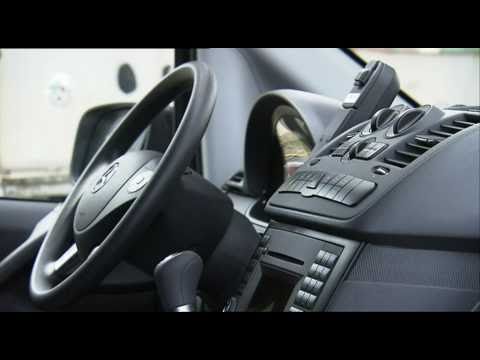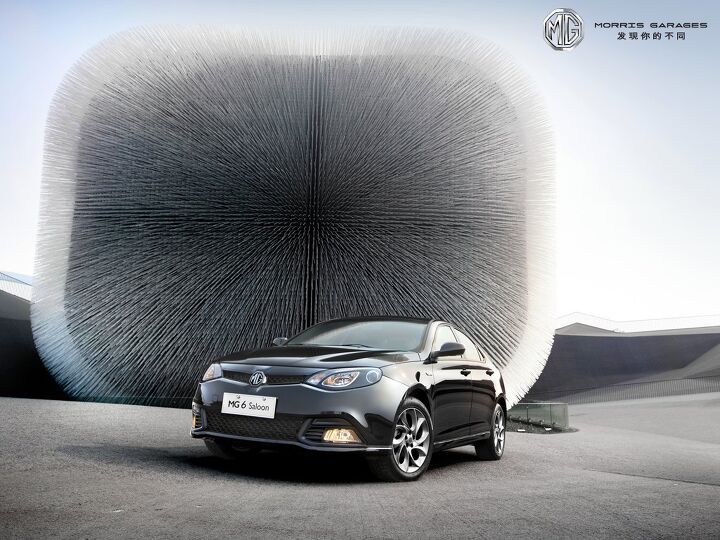Are You Ready For: The Thorium-Laser-Steam-Turbine Electric Powertrain?
Steampunks and Atomic Age nuts rejoice! WardsAuto reports that Connecticut-based Laser Power Systems is “getting closer” to developing a prototype electric car which develops its power using the radioactive heavy metal Thorium. According to LPS’s CEO,
when thorium is heated by an external source, it becomes so dense its molecules give off considerable heat. Small blocks of thorium generate heat surges that are configured as a thorium-based laser… These create steam from water within mini-turbines, generating electricity to drive a car. A 250 MW unit weighing about 500 lbs. (227 kg) would be small and light enough to drop under the hood of a car… Because thorium is so dense, similar to uranium, it stores considerable potential energy: 1 gm of thorium equals the energy of 7,500 gallons (28,391 L) of gasoline. Prototype systems generate electricity within 30 seconds of firing a laser. This can feed power into a car, without the need for storage.
What about radioactivity?
LPS says Thorium’s low levels could be blocked with aluminum foil. Yes, tinfoil. Terrorism? Because the Thorium is not superheated, it does not produce fissile material. Where does Thorium come from? Let’s just say the US has the world’s largest known reserves. General safety? The U.S. Geological Survey’s former senior advisor on rare earths calls the concept “both plausible and sensible.” So why aren’t we driving around thorium-laser-turbine EVs already? According to LPS CEO Charles Stevens. “The issue is having a customized application that is purpose-made,” he says, admitting that developing a portable and usable turbine and generator is proving to be a tougher task than the laser-thorium unit. “How do you take the laser and put these things together efficiently?” he asks rhetorically. But once that is achieved, “This car will run for a million miles. The car will wear out before the engine. There is no oil, no emissions – nothing.” Sounds great… but we’re not holding our breath just yet.
China's July Car Sales Edge Up While Associated Press Slips Badly
From the Detroit News all the way to the Miami Herald, you will receive the good news that “China’s July auto sales are up 6.7 percent.” They are not. According to data released by the China Association of Automobile Manufacturers (CAAM), automobile production in China rose 1.26 percent in July to 1,306,100. Sales rose 2.18 percent to 1,275,300. In case you don’t read Chinese, China Daily provides a translation. The numerical crime was perpetrated again by the Associated Press. The AP is a repeat offender.
Are You Ready For: A 1.2 Liter "Sub-Subcompact" Chevy?
Are You Ready For: Plastic Windows?
As automakers face slowly diminishing returns in their attempts to make internal combustion engines more efficient (while facing huge challenges in electric, hydrogen and other alt-fuel drivetrains), they are looking ever more closely at alternative materials to improve efficiency (and, to a lesser extent, driving pleasure) through weight-savings. Perhaps the biggest emerging trend in this area, especially at the higher end of the market, is in the use of carbon fiber, which is being actively pursued by automakers like BMW, Toyota, Lamborghini and Daimler. But, as WardsAuto points out, there’s another material that’s trying to earn a place in the lightweight cars of tomorrow: polycarbonate plastics.
Polycarbonate windows weigh half as much as glass, and because they are made with injection molding they can come in shapes that can’t be imagined with glass.
However, the material is more expensive. To get auto makers to convert, Sabic and its main material competitor, Bayer MaterialScience, have to sell the idea of integrating other parts into the plastic mold that makes the window.
For example, says Umamaheswara, “on a liftgate, a lot of features can be integrated, and if the manufacturer is short of room in the factory, it can be delivered as a module.”
A modular liftgate could include the window, cladding for the D-pillar, a roof spoiler, the high-mounted rear brake light, a rear wiper foot, handles and logos. When all those processing costs are included, he says, polycarbonate is competitive with glass and metal.
Are You Ready For: Cars That Get Inside Your Head?
Google’s autonomous cars have already shown how close vehicles are to driving themselves in day-to-day traffic, but there’s still one uncontrollable, unpredictable, and often-irrational variable that autonomous cars still struggle to cope with: you, me and all the other haphazardly-programmed human beings on the road. And though predicting human behavior might be one of the most difficult tasks for a human-programmed computer, researchers at MIT are already digging into the challenge. Using model cars (one autonomous, one human-controlled) on overlapping tracks, 97 out of 100 laps avoided collision. But not all of those laps fell into the near-collision “capture set”… which, as it turns out, is what makes the human threat to autonomous cars so challenging.
According to [MIT Mechanical Engineering Professor Domitilla] Del Vecchio, a common challenge for ITS developers is designing a system that is safe without being overly conservative. It’s tempting to treat every vehicle on the road as an “agent that’s playing against you,” she says, and construct hypersensitive systems that consistently react to worst-case scenarios. But with this approach, Del Vecchio says, “you get a system that gives you warnings even when you don’t feel them as necessary. Then you would say, ‘Oh, this warning system doesn’t work,’ and you would neglect it all the time.”
Are You Ready For: A Transit Connect-Based Minivan?
Let’s face a fact here: as much as Jack Baruth likes the Ford Flex, Ford’s MINI-cum-Woodie-Wagon is a textbook case of what the literature refers to as a sales flop. Recommend one to a friend (particularly a friend of the female persuasion) and chances are they’ll say “even if it is a great car, I just don’t like the looks” and go buy a Traverse. For a while there it seemed like a seven-passenger version of Ford’s European C-Max would help the Blue Oval shore up its three-row options, but with that model canceled in favor of a five-door, hybrid-only strategy, Ford’s back to contemplating updates to the Flex. But Automotive News [sub] Product Editor Rick Kranz has another idea:
My understanding is that the next-gen Transit Connect arrives in a few years, will be assembled in North America and will be a more refined vehicle. The current version comes from Turkey…
While today’s Transit Connect seats five, a seven-passenger version could be a viable option for young families that don’t need the Grand Caravan’s bulk. Some urban families might prefer the nimble size of a seven-passenger compact minivan on the narrow neighborhood streets in the Windy City or the Big Apple.
From a business standpoint, Ford could increase Transit Connect volume by offering two flavors — one for commercial applications and the other for mom, dad and the kids.
The main reason the seven-passenger C-Max was nixed: a near-Caravan price point. A TC-based van could come in at a lower price… but would Americans really choose such a utilitarian vehicle? Meanwhile, would a Transit Connect really look that much more appealing than a Flex? It’s an interesting idea that Ford is probably looking at… but what say you?
Are You Ready For: Peer-To-Peer Car Rentals?
With car sharing on the rise, my home state of Oregon is moving towards changing insurance rules to allow private “peer to peer” rentals by auto owners. The Oregonian reports that HB 3149 is headed for the Governor’s desk, having been approved by the state House and Senate. Sponsor Rep Ben Cannon explains
Most insurance policies prohibit people from using their cars for commercial purposes. This bill says someone can participate in car sharing without having to worry that their insurance will be canceled.
California is the only other state to have passed such legislation, and already Facebook-based peer-to-peer car rental firms like Getaround have popped up to fill the demand. With average car ownership costs reaching $8,000 per year according to the AAA, Cannon argues that research showing that cars sit parked for 90% of their lives proves the need for more car-sharing flexibility. And established car-sharing firms like Zipcar, which operate their own fleets don’t feel threatened by the bill, as they are not expanding beyond urban cores and as Zipcar’s CEO puts it, peer-to-peer rentals validate the car-sharing model. But would you rent your car to a stranger?
Are You Ready For: A Neo-xB… With A Twist?
See that? Looks a bit like a first-generation Scion xB, doesn’t it? It’s actually a new Kia, codenamed “Tam,” built on its new A-segment Picanto Morning platform, but featuring first-gen xB-style tall-body MPV packaging. The Picanto’s wheelbase is actually slightly smaller than the xB’s, and there’s another key difference here as well: see that rear door? Look where the handle is placed. That’s right, it’s a slider! But that’s not all…
Are You Ready For: A Smaller Sprinter?
Ford sold 8,834 Transit Connects in 2009, with sales of the small, Euro-style panel and passenger vans hitting 27,405 units last year. With 9,852 already sold in the first third of 2011, it seems the original German delivery van-slingers in the US market, Mercedes, are taking notice of the segment. The Dodge-branded Sprinter, a larger vehicle, saw peak sales of 21,961 back in 2006 has seen sales fall dramatically in recent years, and in 2010 Mercedes wrestled the vans back to its brand, only to sell a meager 8,599 (a nearly 1,500 unit improvement over Dodge’s last year with the product). In other words, the lesson of recent US-market Euro-style delivery vans seems to be that bigger (i.e. more direct competition with American BOF offerings) is not better.
Are You Ready For: A Kia Flagship?
Are you ready to crank some Korean crunk (see video above) and cruise the town in a long, rear-drive, V8-powered… Kia? Get ready, as Kia Motors Australia COO Tony Barolow tells drive.com.au that
We have an interest in all new models under development. A rear-wheel-drive premium sedan could be seen as a logical step from the Optima to the next level of Kia development. It is far too early at this stage to be any more precise about the car but we will definitely maintain a watching brief.
The Hyundai Genesis platform-mate has been photographed in camouflage ( click here for more Korean crunk-free images), and the rumormill has it debuting in Frankfurt this fall, or possibly the NAIAS next January. In any case, get ready for a Schreyer-styled, “proper” Kia flagship to come down the line at some point in the near future.
Are You Ready To: Avoid Traffic Before It Happens?
One of the worst things about traffic is that it’s so unpredictable. You can be whizzing along one minute, and crawling with the snails the next. Even the real-time traffic information that a few companies, notably Google, now provide, can be obsolete by the time you’re on your way.But a small cadre of lucky San Franciscans will soon be finding out where the traffic will be before it happens, thanks to a joint project by the California Center for Innovative Transportation (CCIT) at the University of California, Berkeley (my alma mater) the California Department of Transportation, aka Caltrans, and IBM.
Are You Ready For: A Brand-New British MG?
MG has been building its 1995-era MGF (now MG TF) at its Longbridge, UK plant off and on since 2007, but it’s been a purely knock-down assembly affair, with kits being shipped in from Nanjing, China. But a new British-built MG is about to go into production since the brand was bought by Nanjing Auto in 2005 (Nanjing has since merged with SAIC). Called the MG6, the new compact sedan isn’t completely built at Longbridge (UK workers build and fit the engines, as well as installing the front suspension and subframe, exhaust system and electrics, but bodyshells are shipped from China), but it was designed and engineered at SAIC Motor’s European technical center in the Midlands.
Is that British enough for you?
Are You Ready For: A 180 HP Fiesta?
Ford has made it clear that a 250 HP “ST” version of its 2012 Focus will be making its way to America, hopefully opening a new chapter in Ford’s US-market hot hatch history. The perfect followup? How about a 180 HP Fiesta ST, featuring the new 1.6 liter Ecoboost engine? Autocar says its coming to the UK by the end of this year, and Ford is already teasing its arrival with the release of a “warm” Fiesta, the 134 HP S1600 (above). There’s no word on US availability yet, but if Ford’s going to bring us the Focus ST, why not its baby cousin? With the Fiesta getting plenty of play in rally racing and, far more importantly, Ken Block videos, this seems like an easy call. If nothing else, it will at least look like the bargain of the lifetime compared to the Fiat 500 EV.
Are You Ready For: The Diesel Sportscar?
In the post-Veyron, post-Horsepower Wars world, “Responsible Performance” has been the catchphrase on the lips of every purveyor of performance cars. And with Audi and Nissan already set to brawl for EV sportscar niche that’s being abandoned by Tesla with the forthcoming end of production of its Roadster, diesel power seems to be benefiting from a second look by would-be “responsible performance” vendors.
Unsurprisingly, the tuning houses are promoting their diesel efforts, as EV tuning presents significant challenges to the ICE-based tuning community. And the BMW modifiers at AC Schnitzer are leading the way with this Z4 “99d,” a 188 HP, 310 lb-ft two-liter turbodiesel roadster capable of 146 MPH. Oh yes, and 99 grams of CO2 per Km, or (very roughly) 60-ish MPG (non-EPA). Sound like a healthy compromise between “responsibility” and performance? The only thing you’ll have to give up is the $210,000 that Automobile says this Schintzer concept would cost if it were built.





















Recent Comments